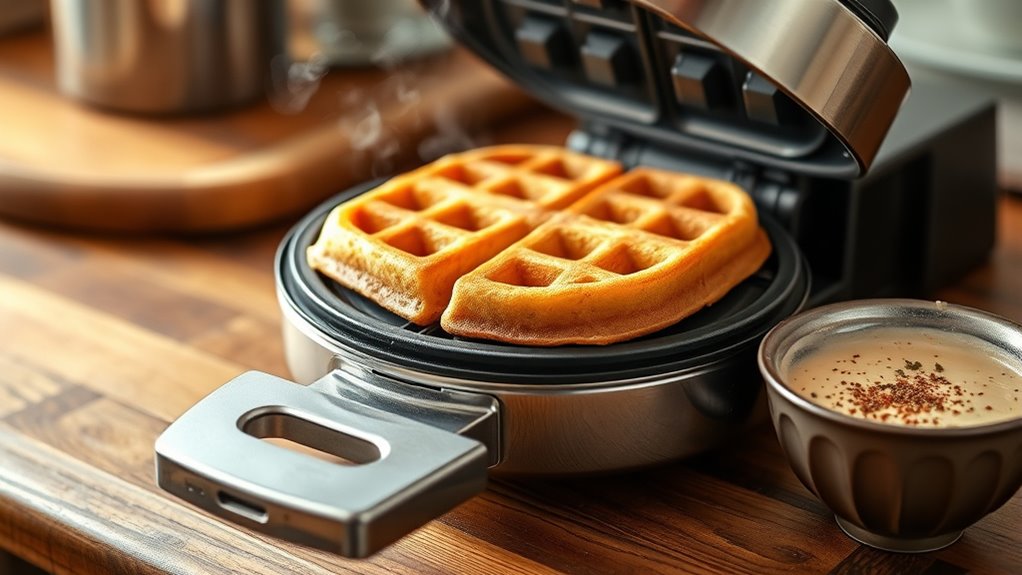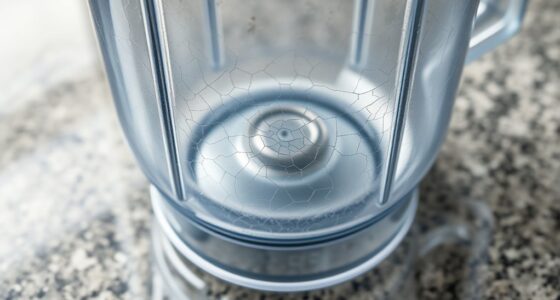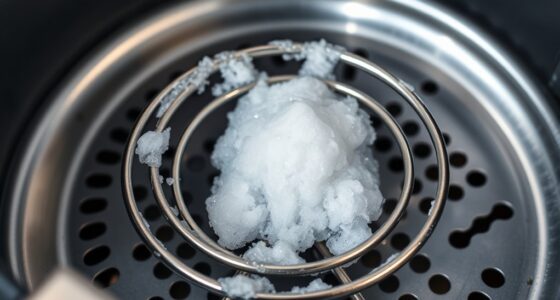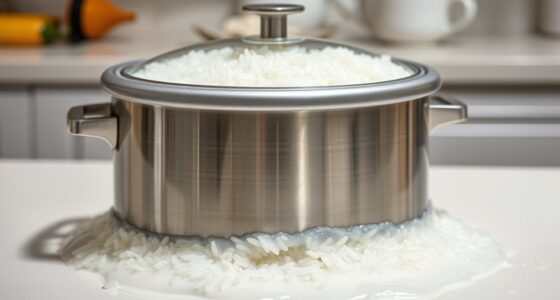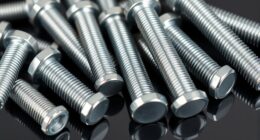If your waffle maker isn’t releasing waffles, start by cleaning the plates thoroughly to remove residue buildup, and make sure they’re properly seasoned with a thin layer of oil to create a non-stick surface. Use the correct batter consistency—thick but pourable—and avoid overfilling to prevent sticking. Also, verify the waffle maker is fully preheated to the right temperature. For more tips on fixing common issues, keep exploring these helpful solutions.
Key Takeaways
- Ensure plates are properly cleaned, seasoned with oil, and free of residue for easy waffle release.
- Preheat the waffle maker fully until indicator signals readiness before pouring batter.
- Use the correct batter consistency—pourable but thick—to prevent sticking and overflowing.
- Avoid overfilling the waffle maker; fill only halfway to two-thirds full for smooth operation.
- Apply a light layer of non-stick spray or oil before each batch to enhance release and prevent sticking.
Check and Clean Your Waffle Maker Plates

To guarantee your waffle maker works properly, start by checking and cleaning the plates. Waffle plate cleaning is essential to prevent residue buildup, which can cause sticking or uneven cooking. Unplug your machine and let it cool completely before cleaning. Use a soft, damp cloth or sponge to wipe the plates gently, removing any crumbs or grease. For stubborn residue buildup, a mixture of mild dish soap and warm water works well—just avoid abrasive cleaners that could damage the surface. Avoid submerging the entire unit in water. Regular cleaning ensures your waffle maker functions smoothly and prolongs its lifespan. Maintaining clean, residue-free plates is the key to perfect waffles every time and prevents common issues like sticking or uneven browning. Additionally, understanding residue buildup patterns can help you identify when a deeper cleaning is necessary.
Properly Season Your Waffle Iron
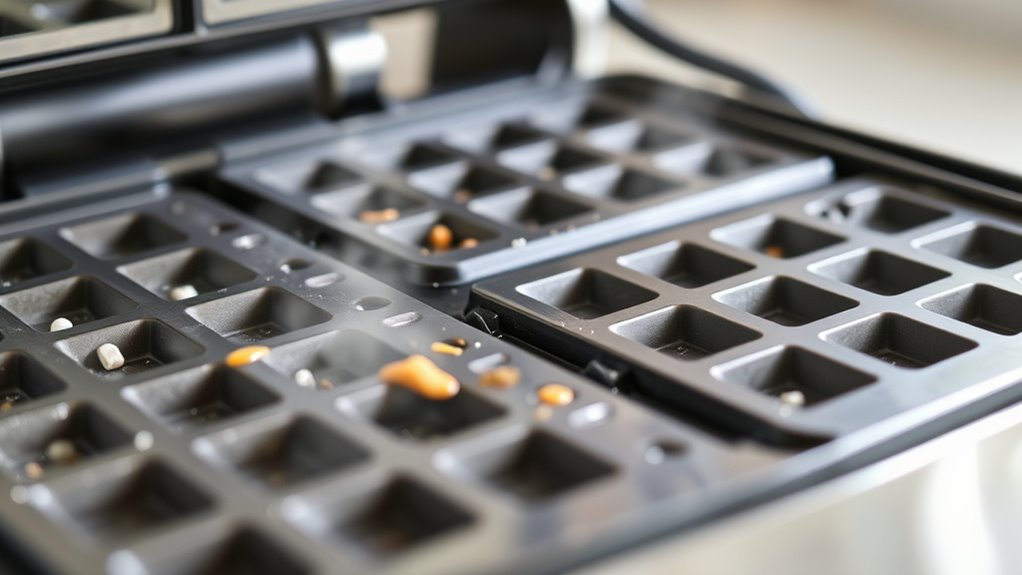
Seasoning your waffle iron creates a natural non-stick surface and helps prevent waffles from sticking or tearing. To start the seasoning process, apply a thin layer of oil or melted shortening to the clean, dry plates. Spread it evenly using a paper towel or brush, ensuring no excess pools. Turn on the waffle maker and let it heat for a few minutes, allowing the oil to bond with the surface. Repeat this process if needed, especially for new or unseasoned irons. Proper seasoning also affects batter consistency; a well-seasoned surface requires less oil in your batter, reducing stickiness. Over time, this builds a protective layer that makes releasing waffles easier and prolongs your waffle maker’s lifespan. Regular seasoning is key to smooth, tear-free waffles. Being aware of gaslighting behaviors can help you recognize and address issues that may arise if your appliance doesn’t operate as expected.
Use the Right Batter Consistency

Making sure your batter has the right thickness is key to perfect waffles. If it’s too thick, they won’t cook evenly; if it’s too thin, they’ll be too flimsy. Proper mixing techniques help you achieve the ideal consistency for crisp, fluffy waffles every time. Additionally, achieving the right batter consistency is essential for the best texture and appearance of your waffles.
Batter Thickness Matters
The consistency of your batter directly impacts how well your waffles turn out. If it’s too thick, the batter won’t spread evenly, leading to dense, undercooked centers. Conversely, if it’s too thin, your waffles may stick to the waffle maker or be overly crispy. Achieving the right batter thickness depends on proper ingredient ratios—using the right amount of liquid to dry ingredients. Using a properly mixed batter can help prevent common issues like sticking or uneven cooking. To get it just right:
- Adjust the amount of milk or water to reach a pourable yet thick consistency
- Use a recipe with balanced ingredient ratios for ideal batter texture
- Test the batter by pouring it into a bowl; it should flow slowly but not be runny
Getting the batter thickness right ensures your waffles cook evenly and release smoothly.
Proper Mixing Techniques
Achieving the perfect batter consistency is only part of the equation; how you mix the ingredients plays a significant role in waffle quality. Proper mixing techniques ensure a uniform mixing consistency, preventing lumps and uneven ingredient distribution. Start by combining dry ingredients separately from wet ones, then gently fold them together. Avoid overmixing, as this can develop gluten and make waffles tough. Instead, mix just until the batter is smooth with no streaks of flour. This careful approach promotes even ingredient distribution, which helps the waffle maker heat evenly and releases the waffle easily. Additionally, mixing techniques can influence the batter’s ability to produce crisp, fluffy waffles and minimize sticking issues. By paying attention to your mixing technique, you’ll create a batter that results in crisp, fluffy waffles and minimizes sticking issues.
Avoid Overfilling the Waffle Maker

Make sure to measure your batter carefully to avoid overfilling the waffle maker. When you add too much, it can spill over and create a mess. Keeping the right amount prevents overflow spills and keeps your machine clean. Using the correct batter consistency also helps control the amount you pour, reducing the risk of overflow.
Measure Batter Carefully
To prevent your waffle from overflowing and creating a mess, it’s vital to measure batter carefully. Proper batter measurement ensures ingredient accuracy, which is key for consistent results and avoiding spills. Use a measuring cup or scoop to add the right amount—usually about half to two-thirds full of the waffle maker’s capacity. Overfilling can cause batter to seep out, making cleanup difficult and risking the waffle maker’s function. Pay close attention to the amount you add, especially when experimenting with new recipes. By maintaining accurate batter measurement, you’ll keep your waffle maker working smoothly. Additionally, understanding how batter consistency affects cooking can help you achieve better results.
Prevent Overflow Spills
Careful measurement of batter plays a big role in preventing overflow spills, but it’s equally important to pay attention to how much you pour into the waffle maker. Overfilling can lead to waffle batter spilling out and creating a mess. To ensure overflow prevention, pour just enough batter to fill the grid without overfilling the edges. Use a ladle or measuring cup for consistency, and avoid adding too much at once. Keep an eye on the batter as it cooks—if it starts to rise above the edges, stop pouring immediately. Properly controlling the amount of waffle batter helps prevent spills, keeps your kitchen clean, and ensures perfectly cooked waffles every time. Remember, less is often more when it comes to avoiding overflow spills. Additionally, understanding the shower design and installation tips can inspire you to create a more functional and modern bathroom space.
Apply a Suitable Non-Stick Spray or Oil

Applying a suitable non-stick spray or oil is essential for preventing your waffle from sticking and ensuring easy removal. Proper oil application creates a barrier between the batter and the waffle maker’s surface, reducing the chances of sticking. Before pouring your batter, spray the non-stick spray evenly or brush a thin layer of oil onto the plates. Be sure to cover all surfaces where the batter will touch. Using the right amount prevents excess residue and smoke. Remember to reapply oil as needed for multiple uses. Additionally, choosing high-quality non-stick coatings can enhance the durability and effectiveness of your waffle maker’s surface, making future batches even easier to remove.
Allow the Waffle Maker to Reach Proper Temperature

Allowing your waffle maker to reach the proper temperature is essential for achieving perfectly cooked waffles. Proper temperature regulation ensures the batter cooks evenly and prevents sticking or undercooking. Before pouring batter, turn on your waffle maker and give it time to heat up fully. The heating element needs to reach the ideal temperature, which is usually indicated by an indicator light or a specific temperature setting. If your waffle maker has adjustable controls, set it to the recommended level for your recipe. Rushing this step can lead to waffles that don’t release easily or have uneven texture. Be patient and wait until the appliance signals it has reached the right temperature. This step helps ensure consistent, delicious results and reduces the chance of waffles sticking or failing to release. Monitoring the temperature with an appropriate tool can further help achieve optimal cooking conditions.
Troubleshoot for Mechanical or Surface Issues
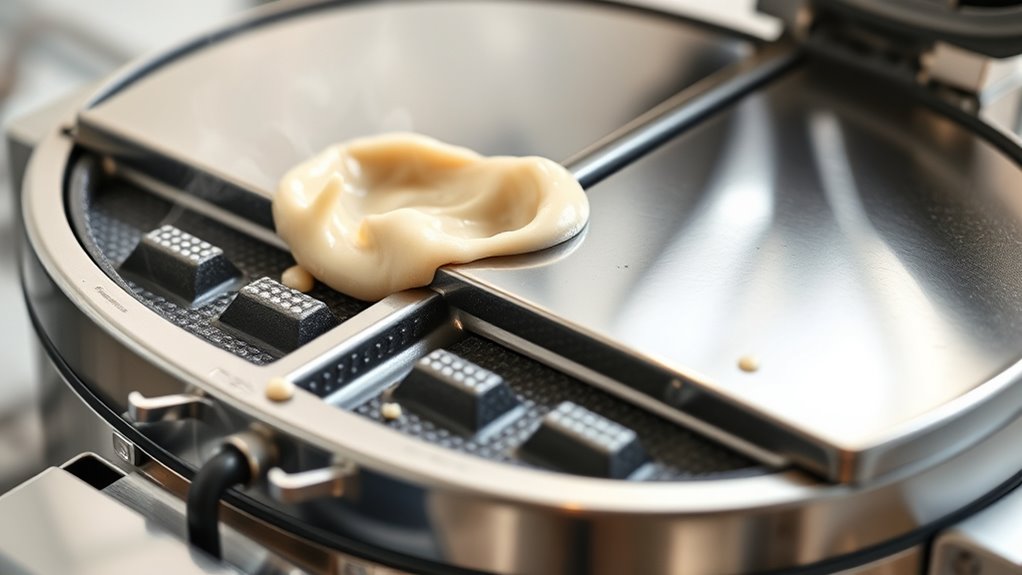
If your waffle maker isn’t functioning properly, inspecting it for mechanical or surface issues can often identify the problem. Surface buildup or misaligned plates can affect waffle texture and increase cooking time. Mechanical problems, like a faulty thermostat or broken hinge, may prevent even heating or proper closure. Check for debris or residue on the plates, which can lead to uneven browning or sticking. Verify the plates are aligned correctly and clean. If the surface is scratched or damaged, it might hinder heat transfer, affecting waffle texture. Additionally, listen for unusual noises or see if the indicator lights respond properly. Troubleshooting these issues helps restore ideal cooking time and consistent waffle quality. Additionally, inspecting the heating elements can help ensure proper temperature regulation.
- Clean and inspect the plates for residue or damage
- Check for proper alignment and secure closure
- Test electrical components or replace faulty parts
Frequently Asked Questions
Can Mineral Deposits Cause My Waffle Maker to Stick?
Yes, mineral deposits like calcium buildup can cause your waffle maker to stick. Over time, minerals from water can accumulate inside the plates, creating a rough surface that hinders the release of waffles. To prevent this, regularly clean your waffle maker with vinegar or a descaling solution to dissolve mineral deposits. Keeping the plates well-seasoned and dry also helps reduce calcium buildup and guarantees easy release every time.
How Often Should I Reseason My Waffle Iron?
You should reseason your waffle iron every 3 to 6 months to maintain proper seasoning. Regular seasoning maintenance helps prevent sticking and extends your waffle iron’s lifespan. If you notice your waffles start sticking more often, it’s a sign to reseason sooner. Consistent upkeep guarantees your waffle maker remains in top condition, making clean-up easier and ensuring each waffle turns out perfect.
Is It Safe to Use Butter Instead of Oil?
Using butter instead of oil is generally safe for seasoning your waffle iron, but it’s not ideal. Butter has a lower smoke point and contains milk solids that can burn and cause sticking, like a forgotten relic in your toolbox. For a safer, more effective seasoning, stick with oil. It creates a durable non-stick surface without the risk of burning or damaging your waffle maker, ensuring tasty waffles every time.
What Types of Batter Are Best for Non-Stick Surfaces?
For non-stick surfaces, you want a batter with a smooth, medium consistency that’s not too thick or runny. This guarantees easy release and even cooking. If you’re using gluten-free options, opt for batters with a bit more liquid and binding agents like eggs or xanthan gum to maintain texture. Avoid overly thick batters, as they can stick, and always preheat your waffle maker for best results.
How Do I Prevent Rust on My Waffle Maker?
To prevent rust on your waffle maker, make sure you regularly clean it with gentle cleaning techniques, avoiding abrasive scrubbers that can damage the non-stick coating. After each use, thoroughly dry the appliance, especially in crevices, to prevent moisture buildup. Apply a light coat of mineral oil or a food-safe lubricant to the non-stick surface periodically. Proper maintenance and careful cleaning help preserve your waffle maker and keep rust at bay.
Conclusion
Just like a trusted cast iron skillet, your waffle maker needs care and patience. With a little tuning—cleaning, seasoning, and the right batter—you’ll have it releasing waffles effortlessly. Think of it as taming a wild stallion; once you understand its needs, it’ll perform like a champion. Keep troubleshooting and maintaining it, and soon your waffle maker will be as reliable as the sunrise, ready to serve up perfect breakfast every time.
